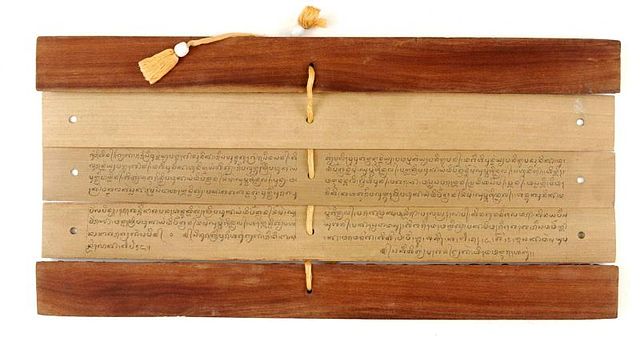Palm-leaf manuscripts are manuscripts made out of dried palm leaves. Palm leaves were used as writing materials in the Indian subcontinent and in Southeast Asia dating back to the 5th century BCE. Their use began in South Asia and spread to other regions, as texts on dried and smoke-treated palm leaves of the Palmyra or talipot palm.
Their use continued until the 19th century when printing presses replaced hand-written manuscripts.
Palm leaf manuscripts of 16th century in Odia script
16th-century Hindu Bhagavata Purana on palm leaf manuscript
A palm leaf Hindu text manuscript (Lontara) from Bali, Indonesia, showing how the manuscripts were tied into a book
A medical manuscript in Sinhala, c. 1700
A manuscript was, traditionally, any document written by hand or typewritten, as opposed to mechanically printed or reproduced in some indirect or automated way. More recently, the term has come to be understood to further include any written, typed, or word-processed copy of an author's work, as distinguished from the rendition as a printed version of the same.
Christ Pantocrator seated in a capital "U" in an illuminated manuscript from the Badische Landesbibliothek, Germany (from c. 1220).
Image of two facing pages of the illuminated manuscript of "Isagoge", fols. 42b and 43a. On the top of the left hand page is an illuminated letter "D" – initial of "De urinarum differencia negocium" (The matter of the differences of urines). Inside the letter is a picture of a master on bench pointing at a raised flask while lecturing on the "Book on urines" of Theophilus. The right hand page is only shown in part. On its very bottom is an illuminated letter "U" – initial of "Urina ergo est colamentum sanguinis" (Urine is the filtrate of the blood). Inside the letter is a picture of a master holding up a flask while explaining the diagnostic significance of urine to a student or a patient. HMD Collection, MS E 78.
Inside the letter is a picture of a master in cathedra expounding on the Aphorisms of Hippocrates. Initial "V" rendered as "U" of "Vita brevis, ars vero longa", or "Life is short, but the art is long". "Isagoge", fol. 15b. HMD Collection, MS E 78.
Manuscript, Codex Manesse. Most manuscripts were ruled with horizontal lines that served as the baselines on which the text was entered.








